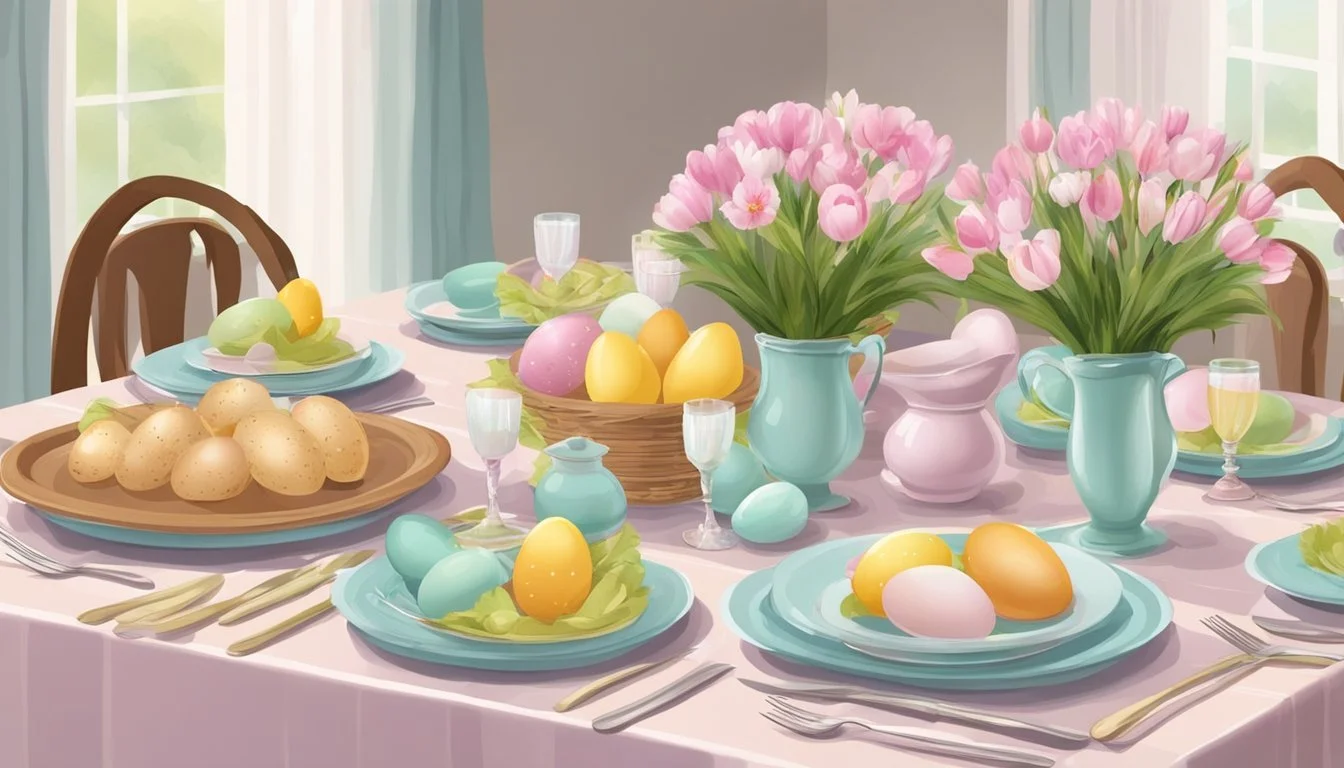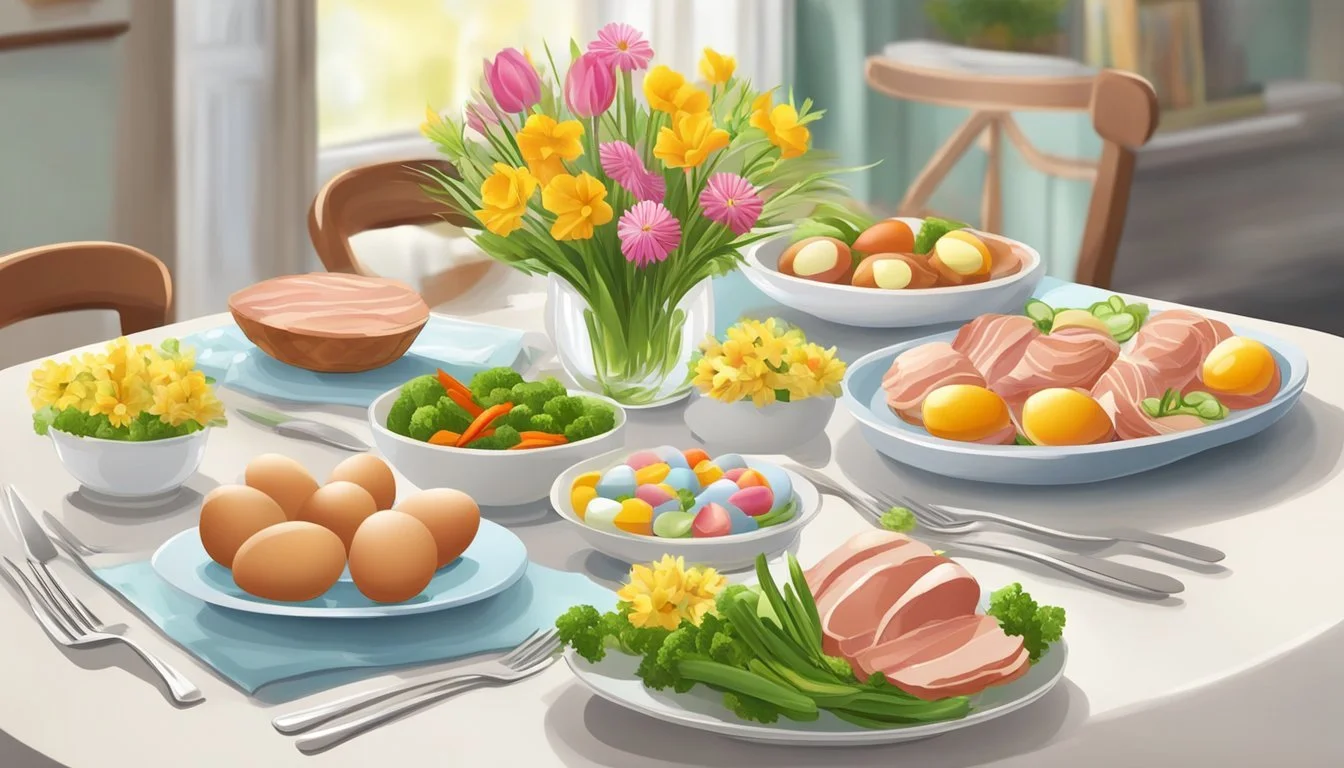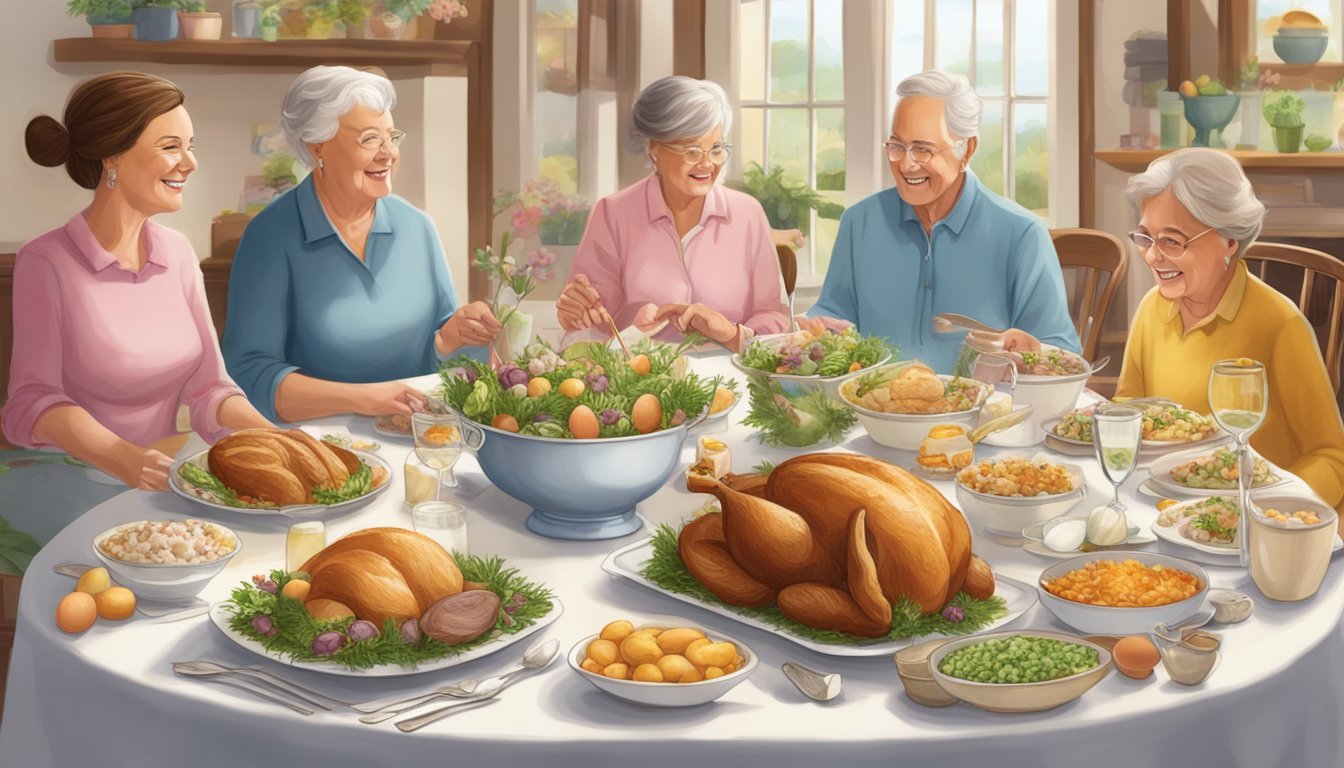Heirloom Easter Recipes
Traditional Flavors Shared Across Generations
Easter marks a time for communities to gather, embrace the spirit of spring, and celebrate traditions both old and new. This holiday has long held a cherished place in the hearts of families, often celebrated with an array of dishes that are as rich in flavor as they are in history. Heirloom recipes are passed down through generations, symbolizing the continuity of family heritage and community bonds.
In many homes, these recipes are a testament to culinary legacies that have stood the test of time, serving as a centerpiece for the Easter meal. They are relics of familial affection, each dish telling a story of past celebrations and shared joy. The art of cooking these age-old recipes provides an opportunity for family members to connect with their ancestry and introduce time-honored traditions to the younger generation.
Easter, while signaling the rejuvenating season of spring, thus becomes more than just a holiday; it's a gathering of past and present, where heirloom recipes act as a vessel of culture and communal memory. From savory meats prepared with skilled hands to comforting casseroles (What wine goes well with casseroles?) and sweet confections, these dishes are a lovingly curated homage to the generations that laid the foundations of these festive commemorations. They embody the essence of Easter, weaving the fabric of family history into every bite.
The Significance of Easter Traditions
Easter traditions hold a central place in the cultural and spiritual lives of many families. At its core, Easter is a celebration of renewal and rebirth, themes that are reflected both in religious observances and in the time-honored customs that bring families together.
Family gatherings are pivotal during Easter, as they offer a sense of togetherness and continuity. The Easter meal is a cherished convocation, often featuring heirloom recipes passed down through generations. These recipes are much more than mere instructions for preparing food; they are tangible links to the past, serving as a means to transmit heritage and values.
The Easter table is typically laden with symbolic and flavorful dishes that vary from one culture to another. For instance, lamb is a traditional centerpiece in many Easter meals, representing comfort, celebration, and rich historical symbolism dating back to Passover observances. The inclusion of eggs at the Easter table, often decorated and painted, is emblematic of fertility and new life, reinforcing the essence of Easter's message.
Easter recipes themselves are an expression of tradition, with each family often having their own twist on classic dishes. Preparing these meals together can be a comforting ritual, offering a space for families to bond and share stories.
In essence, Easter is enriched by a tapeastry of traditions that are both personal and universal. They honor the significance of the occasion, provide comfort, and cement the role of family in celebrating this historic festival.
Symbol Significance in Easter Traditions Egg New life, fertility Lamb Sacrifice, comfort Family Togetherness, heritage Meal Celebration, continuity
These elements, when woven together, create a tapestry of Easter celebrations that are as diverse as they are similar, underpinning the power of tradition in maintaining connections across time and place.
Heirloom Easter Appetizers
Heirloom recipes serve as a bridge between generations, carrying the tastes and traditions of the past into present celebrations. The appetizers selected for Easter reflect a family's history and can make the holiday meal feel particularly special.
Best Deviled Eggs
Ingredients:
Eggs
Mayonnaise
Mustard
Salt and pepper
Paprika (for garnish)
Method:
Eggs are hard-boiled, peeled, and halved lengthwise.
Yolks are removed and mixed with mayonnaise and mustard to create a smooth filling.
The mixture is then seasoned with salt and pepper to taste.
Spoon or pipe the filling back into the egg whites.
A sprinkle of paprika adds the final touch.
Deviled eggs hold the banner high for Easter appetizers, with each family boasting its "best" rendition of this classic. They should be creamy and delicately seasoned, with a dusting of paprika for color and a subtle hit of spice.
Easter Pie Selection
Savory Pies:
Traditional Easter Pie with layers of cheese and cured meats (What wine goes well with cured meats?).
A vegetarian option with spinach and ricotta.
Smoked Salmon Pie:
Flaky pastry filled with smoked salmon, (What wine goes well with salmon?) fresh dill, and cream cheese.
A selection of Easter Pies offers variety to guests, balancing rich flavors with delicate, buttery pastries. The traditional Easter Pie, packed with a mixture of savory cheeses and meats, is a filling choice. For those seeking a lighter option, a smoked salmon pie with its elegant and luxurious flavor profile creates a delightful contrast.
Classic Easter Mains
Easter dinner (What wine goes well with dinner?) is a time for cherished traditions and family favorites, where the main courses often feature a stunning centerpiece of either ham or lamb. These centerpieces are not only a feast for the palate but also for the eyes, with glazes and herbs that bring out their rich flavors.
Perfect Glazed Ham
The Perfect Glazed Ham is a staple of many Easter dinners, establishing itself as a succulent dish with a balance of sweet and savory flavors. Traditionally, the ham is scored in a diamond pattern, studded with cloves, and glazed with a mixture that often includes:
Brown sugar or honey for sweetness
Mustard or vinegar for a sharp counterpoint
Spices such as cinnamon or ginger for warmth
Cooking Tips:
Bake the ham at 325°F until it reaches an internal temperature of 140°F.
Apply the glaze during the last 45 minutes of baking to create a caramelized crust.
Roast Lamb Traditions
Roast Lamb stands as a symbol of spring and is another beloved choice for Easter dinner. It's often prepared with:
Fresh herbs (how long do fresh herbs last?) like rosemary and thyme to enhance its earthy flavor
Garlic slivers inserted into slits in the meat for additional pungency
Roast Lamb Recommendations:
Roast at 375°F until it reaches the desired doneness (145°F for medium-rare).
Let it rest before carving to ensure moist, tender slices.
Both main dishes, whether ham or lamb, embrace Easter's renewal theme and are celebrated for bringing families together over a meal that's rich in history and flavor.
Easter Side Dishes
Easter celebrations are often accompanied by a feast that brings families together, and no feast is complete without side dishes that complement the main course. Heirloom side dishes add a touch of nostalgia and tradition to the table, showcasing recipes passed down through generations.
Scalloped Potatoes Delight
Scalloped potatoes are a classic dish that combine thin slices of potato with rich, creamy sauce. They are baked until golden and bubbly, resulting in a comforting side that is sure to please any crowd. To prepare Scalloped Potatoes Delight, one needs russet or Yukon Gold potatoes, a blend of melted butter, flour for thickness, and warmed milk to create the smooth sauce. Seasoning the dish with salt and a hint of garlic enhances the flavors, while a generous addition of grated cheese such as cheddar adds decadence.
Green Bean Casserole
A staple at many Easter tables, Green Bean Casserole consists of green beans in a creamy mushroom sauce, topped with crispy fried onions. Fresh or canned green beans work equally well in this dish. A homemade sauce can be made using butter, flour, and milk or cream, with a touch of soy sauce for depth. To achieve a richer flavor, freshly chopped mushrooms sautéed in butter are preferred over canned versions. Salt and pepper should be used to taste. The final touch—a sprinkle of crispy onions—adds an irresistible crunch.
Carrot Salad Essentials
For a lighter addition to the Easter meal, Carrot Salad Essentials features the natural sweetness of carrots balanced with the tang of a lemon or vinegar-based dressing. Shredded carrots provide the base, and ingredients such as raisins or pineapple chunks add texture and sweetness. A dressing made with sugar, lemon juice or vinegar, and a dash of salt creates a simple yet vibrant coating for the salad. Optional ingredients like chopped nuts or parsley can be included for additional flavor and variety. A dollop of mayonnaise or yogurt can be mixed in for creaminess, if desired.
Incorporating these side dishes into the Easter feast not only provides a comforting and familiar taste but also honors the culinary heritage of families, keeping the spirit of tradition alive for future generations.
Easter Bread & Pastry
In the tapestry of Easter celebrations, bread and pastry take center stage with traditions that reflect a rich cultural heritage. Recipes are often rich in eggs, sugar, and butter, creating a memorable taste experience during this festive holiday.
Italian Easter Bread
Italian Easter bread is a sweet, yeasted dough typically enriched with eggs, sugar, and butter. A hallmark of this bread is its decoration with dyed Easter eggs nestled into braids of the bread itself. Essential ingredients include:
All-purpose flour
Granulated sugar
Unsalted butter
Eggs
Ricotta cheese (for some variations)
Finely grated orange or lemon zest for added flavor
Some versions incorporate poppyseed, while others remain plain but are adorned festively to symbolize the joy of the holiday.
Hot Cross Buns How-to
Hot cross buns, a traditional Good Friday treat, feature a spiced sweet dough often containing currants or raisins. Key components of hot cross buns include:
Flour (to create a tender crumb)
Sugar (for a bit of sweetness)
Butter (adds moisture and richness)
Eggs (for a richer dough)
Mixed spices (such as cinnamon, nutmeg, and allspice)
They are distinguished by their iconic cross atop each bun, typically made from a flour and water paste, piped over the buns before baking. They're traditionally served on Good Friday, hence marking the end of Lent with their sweet and spiced flavor.
Spring-Inspired Easter Desserts
Easter desserts are a wonderful culmination of fresh flavors and traditional recipes that symbolize the newness of spring. From the tangy zest of lemons to the sweet, earthy taste of carrots, each recipe offers a nostalgic yet novel way to celebrate the season.
Lemon Meringue Pie Perfection
A classic Lemon Meringue Pie incorporates a buttery crust, filled with a smooth, tart lemon custard. The pie is perfected with a glossy, light meringue topping that's toasted to a golden brown. The key ingredients are sugar, fresh lemon zest, and eggs, balancing sweetness and zestiness to create a refreshing dessert.
Classic Carrot Cake
Carrot Cake with Cream Cheese Frosting is the embodiment of spring with its moist texture and warming spices. Its rich flavor comes from freshly grated carrots and its delightfully creamy frosting is made with a velvety blend of cream cheese, sugar, and butter. Sprinkling toasted pecans or walnuts adds a pleasant crunch to this beloved dessert.
Strawberry Shortcake
Strawberry Shortcake is a celebration of spring's bounty with ripe, juicy strawberries layered with fluffy, lightly sweetened biscuits. A dollop of whipped cream adds a luxurious finish to this simple yet soulful dessert. The contrast of the tender berries and the light, crumbly biscuit captures the essence of the season's freshness.
Casual Easter Brunch Ideas
Easter brunch (What wine goes well with brunch?) is an opportunity for friends and family to gather and celebrate with comforting, delicious food. Dishes that can be prepared ahead of time are essential, allowing hosts to enjoy the festivity without being tied to the kitchen.
Breakfast Casserole Favorites
Breakfast casseroles are the epitome of casual Easter brunch fare. They can often be assembled the night before and baked in the morning, offering ease and convenience.
Strawberry Cream Cheese French Toast: This casserole is a sweet start to Easter Sunday, utilizing fresh, seasonal strawberries. Bake until golden and serve with warm, homemade strawberry sauce.
Egg Salad: Transform classic eggs into a delightful egg salad as a side or a light main dish. Enhance the flavor with a dollop of sour cream and serve on a bed of greens or with crusty bread.
Baked Salmon & Sides
Baked salmon makes an elegant yet effortless main course, providing a lighter option for guests.
Herb-Crusted Baked Salmon: Season the salmon with a blend of fresh herbs and bake to perfection. The dish takes minimal prep time and cooks quickly, which is ideal for a relaxed gathering.
Berry Spinach Salad: Pair the salmon with a vibrant berry spinach salad. Toss fresh spinach with a mix of berries, nuts, and a light vinaigrette for a refreshing side.
Brussels Sprout Salad: For a heartier side option, consider a Brussels sprout salad. Shave the sprouts thinly and dress them with a mustard vinaigrette for a crunchy, tangy accompaniment.
By focusing on these simple yet indulgent brunch options, hosts can offer a spread that is both satisfying and manageable.
Easter Dinner Finale
The Easter dinner grand finale touches on tradition, while incorporating innovative twists that leave a memorable impression. Succulent roast chicken and a sweetly savory corn pudding stand as testament to the holiday's rich flavors.
Roast Chicken with a Twist
For many, a golden-brown roast chicken is the centerpiece of Easter dinner. The key to this dish is a perfect harmony of herbs and a unique addition: a glaze of asparagus coulis. Marinate the chicken with a mixture of garlic, rosemary, thyme, and a hint of lemon to infuse it with springtime flavors. After roasting to perfection, one can brush the asparagus coulis over the chicken, providing not only a vibrant green highlight but also a nutrient-rich enhancement to the already delectable dish.
Honey Mustard Corn Pudding
As a side that stands out, Honey Mustard Corn Pudding combines the comforting sweetness of corn with the tangy kick of honey mustard. This dish is a delicate balance of flavors that compliments the main course without overpowering it.
Ingredients:
Corn kernels
Whole milk
Eggs
Honey
Dijon mustard
One should gently fold the mixture of fresh corn kernels, whisked eggs, and whole milk, seasoned with salt and pepper, then swirl in a generous amount of honey and a touch of Dijon mustard before baking. The result is a creamy pudding with a crispy, caramelized top, a festive nod to the sweetness of Easter.
Storing Leftovers
When Easter celebrations wind down, families are often left with a sizeable amount of leftovers. Proper storage is crucial to extend the shelf life of food, maintain its quality, and ensure safety. Here are some refrigerator-friendly tips to keep in mind.
Refrigerator-Friendly Tips
Eggs: Hard-boiled eggs should be refrigerated within two hours of cooking and can be stored in their shells for a week. For peeled eggs, keep them in a bowl of cold water or a damp paper towel in an airtight container.
Ham: Cooked ham can be safely stored in the refrigerator for 3-4 days. Wrap it tightly in aluminum foil or place it in an airtight container to prevent it from drying out.
Food Safety: All leftovers should be packed in shallow containers to allow for quick cooling. Most cooked foods, like easter dishes, should be consumed within 3-4 days to minimize the risk of foodborne illness.
Temperature: Ensure your refrigerator is at a safe 40°F (4°C) or below to prevent bacterial growth.
Labeling: Date leftovers before storing them so you know when they need to be eaten or frozen for longer storage.
Lemon: The acidity in lemon juice can help preserve the freshness of certain leftovers. A small squeeze over ham or vegetables before refrigerating can make a difference.
By following these tips, one can safely enjoy their Easter feast for days to come without compromising on the quality and safety of the food.










